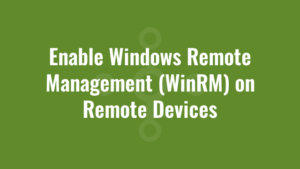I recently wanted to run some PowerShell code remotely, but a requirement of this is that WinRM is enabled on the remote device. So we needed to work out how to enable windows remote management (WinRM) on remote devices….without using WinRM to enable it!
Enable Windows Remote Management (WinRM) on Remote Devices
As discussed, to enable PowerShell remoting we must enable WinRM on the remote device.
Since WinRM will be currently disabled, we must find a way of enabling it remotely without using WinRM! And luckily we can use Invoke-WmiMethod to invoke a process on a remote device.
We’ve wrapped it up in a function
Function Enable-WinRM {
param(
$computerName,
$testAttempts, #how many times to check if service is enabled
$testIntervalSeconds #the time in seconds between each check
)
if (Test-Connection $computerName) {
write-host "Successfully pinged $computerName"
if (!(Test-WSMan $computerName -ErrorAction SilentlyContinue)) {
#WinRM not enabled - enable it
Invoke-WmiMethod -ComputerName $computerName -Path win32_process -Name create -ArgumentList "powershell.exe -command Enable-PSRemoting -SkipNetworkProfileCheck -Force"
Invoke-WmiMethod -ComputerName $computerName -Path win32_process -Name create -ArgumentList "powershell.exe -command WinRM QuickConfig -Quiet"
$currentAttempt = 1
while (!(Test-WSMan $ComputerName -ErrorAction SilentlyContinue)) {
write-host "Attempt $currentAttempt..."
if ($currentAttempt -eq $testAttempts) {
write-host "Could not enable WinRM on $ComputerName"
return $false
}
Start-Sleep -Seconds $testIntervalSeconds
$currentAttempt ++
}
write-host "WinRM enabled on $computerName"
return $true
} else {
write-host "WinRM enabled on $computerName"
return $true
}
} else {
write-host "Cannot ping $computerName"
return $false
}
}
#specify machines to enable WinRM/run scriptblock on
$Computers = "localhost","computer2"
$scriptblock = {
param($Computer)
#enable remote registry service
$returnMessage = ""
$RemoteRegistry = Get-CimInstance -Class Win32_Service -ComputerName $Computer -Filter 'Name = "RemoteRegistry"' -ErrorAction Stop
if ($RemoteRegistry.State -eq 'Running') {
$returnMessage = "Remote registry on $Computer is already Enabled"
}
if ($RemoteRegistry.StartMode -eq 'Disabled') {
Set-Service -Name RemoteRegistry -ComputerName $Computer -StartupType Manual -ErrorAction Stop
$returnMessage = "Remote registry on $Computer has been Enabled"
}
if ($RemoteRegistry.State -eq 'Stopped') {
Start-Service -InputObject (Get-Service -Name RemoteRegistry -ComputerName $Computer) -ErrorAction Stop
$returnMessage = "Remote registry on $Computer has been Started"
}
return $returnMessage
}
foreach ($ComputerName in $Computers) {
#try and enable PS Remoting - test if WinRM is enabled 2 times and wait 5 seconds in between testing
if (Enable-WinRM $ComputerName 2 5) {
#if we manage to enable WinRM, we can then run whatever we want using Invoke-Command!
try {
$returnMessage = Invoke-Command -ComputerName $ComputerName -ScriptBlock $scriptblock -ArgumentList $ComputerName
write-host $returnMessage
} catch {
write-host $_.exception.message
}
}
}You can see in the above that once we enable remoting, we can then use Invoke-Command to enable the remote registry service!





